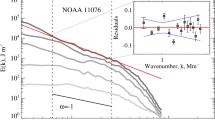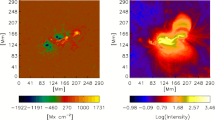Abstract
Line-of-sight magnetograms acquired by the Helioseismic and Magnetic Imager (HMI) onboard the Solar Dynamic Observatory (SDO) and by the Michelson Doppler Imager (MDI) onboard the Solar and Heliospheric Observatory (SOHO) for 14 emerging ARs were used to study the derivative of the total unsigned flux–the flux emergence rate, R(t). We found that the emergence regime is not universal: each AR displays a unique emergence process. Nevertheless, two types of the emergence process can be identified. First type is a “regular” emergence with quasi-constant behavior of R(t) during a 1–3 day emergence interval with a rather low magnitude of the flux derivative, Rmax = (0.57 ± 0.22) × 1022 Mx day–1. The second type can be described as “accelerated” emergence with a long interval (>1 day) of the rapidly increasing flux derivative R(t) that result in a rather high magnitude of Rmax= (0.92 ± 0.29) × 1022 Mx day–1, which later changes to a very short (about a one third of day) interval of R(t) = const followed by a monotonous decrease of R(t). The first type events might be associated with emergence of a flux tube with a constant amount of flux that rises through the photosphere with a quasi-constant speed. Such events can be explained by the traditional largescale solar dynamo generating the toroidal flux deep in the convective zone. The second-type events can be interpreted as a signature of sub-surface turbulent dynamo action that generates additional magnetic flux (via turbulent motions) as the magnetic structure makes its way up to the solar surface.
Similar content being viewed by others
References
Abramenko, V.I., Yurchyshyn, V.B., and Goode, P.R., Observational signatures of the small-scale dynamo in the quiet Sun, ASP Conf. Ser., 2012, vol. 455, pp. 17–24.
Brandenburg, A., Sokoloff, D., and Subramanian, K., Current status of turbulent dynamo theory. From large-scale to small-scale dynamos, Space Sci. Rev., 2012, vol. 169, pp. 123–157.
Cattaneo, F., On the origin of magnetic fields in the quiet photosphere, Astrophys. J., 1999, vol. 515, pp. L39–L42.
Charbonneau, P., Dynamo models of the solar cycle, Living Rev. Sol. Phys., 2010, vol. 7, id 3.
Hagenaar, H., Ephemeral regions on a sequence of full-disk Michelson Doppler Imager magnetograms, Astrophys. J., 2001, vol. 555, pp. 448–461.
Kutsenko, A.S. and Abramenko, V.I., Using SDO/HMI magnetograms as a source of the solar mean magnetic field data, Sol. Phys., 2016, vol. 291, pp. 1613–1623.
Liu, Y., Zhao, X., and Hoeksema, J.T., Correction of offset in MDI/SOHO magnetograms, Sol. Phys., 2004, vol. 219, pp. 39–53.
Liu, Y., Hoeksema, J.T., Scherrer, P.H., et al., Comparison of line-of-sight magnetograms taken by the Solar Dynamics Observatory/Helioseismic and Magnetic Imager and Solar and Heliospheric Observatory/Michelson Doppler Imager, Sol. Phys., 2012, vol. 279, no. 1, pp. 295–316.
Miesch, M.S., The dynamo dialectic: An inside look at the current solar minimum, ASP Conf. Ser., 2010, vol. 428, pp. 29–36.
Miesch, M.S., The solar dynamo, philosophical transactions, Philos. Trans. R. Soc., A, 2012, vol. 370, pp. 3049–3069.
Parker, E.N., The formation of sunspots from the solar toroidal field, Astrophys. J., 1955, vol. 121, pp. 491–507.
Pietarila Graham, J., Cameron, R., and Schüssler, M., Turbulent small-scale dynamo action in solar surface simulations, Astrophys. J., 2010, vol. 714, pp. 1606–1616.
Scherrer, P.H., Bogart, R.S., Bush, R.I., et al., The Solar Oscillations Investigation—Michelson Doppler Imager, Sol. Phys., 1995, vol. 162, nos. 1–2, pp. 129–188.
Scherrer, P.H., Schou, J., Bush, R.I., et al., The helioseismic and magnetic imager (HMI) investigation for the solar dynamics observatory (SDO), Sol. Phys., 2012, vol. 275, pp. 207–227.
Schrijver, C.J. and Zwaan, C., Solar and Stellar Magnetic Activity, Cambridge: Cambridge Univ. Press, 2000.
Shibalova, A.S., Obridko, V.N., and Sokoloff, D.D., Intermittency of the solar magnetic field and solar magnetic activity cycle, Sol. Phys., 2017, vol. 292, no. 3, id 44. doi 10.1007/s11207-017-1069-4
Sokoloff, D.D., Khlystova, A., and Abramenko, V., Solar small-scale dynamo and polarity of sunspot groups, Mon. Not. R. Astron. Soc., 2015, vol. 451, pp. 1522–1527.
Ugarte-Urra, I., Upton, L., Warren, H.P., and Hathaway, D.H., Magnetic flux transport and the long-term evolution of solar active regions, Astrophys. J., 2015, vol. 815, pp. 90–98.
Vögler, A. and Schüssler, M., A solar surface dynamo, Astron. Astrophys., 2007, vol. 465, pp. L43–L46.
Zwaan, C., A dynamo scenario: Observational constraints on dynamo theory, Sol. Phys., 1996, vol. 169, pp. 265–276.
Author information
Authors and Affiliations
Corresponding author
Additional information
The article is published in the original.
Rights and permissions
About this article
Cite this article
Abramenko, V.I., Tikhonova, O.I. & Kutsenko, A.S. Diagnostics of Turbulent Dynamo from the Flux Emergence Rate in Solar Active Regions. Geomagn. Aeron. 57, 792–797 (2017). https://doi.org/10.1134/S0016793217070027
Received:
Accepted:
Published:
Issue Date:
DOI: https://doi.org/10.1134/S0016793217070027




